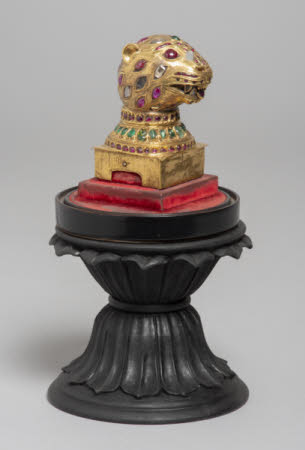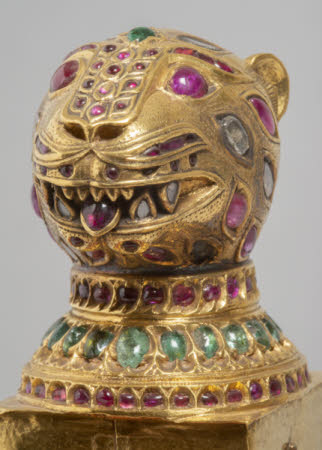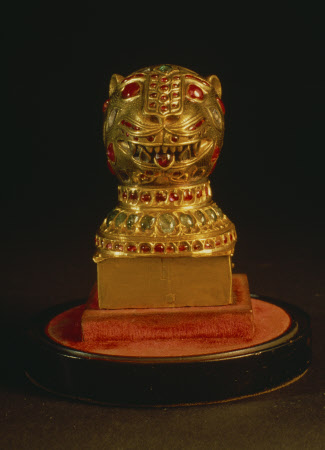Finial
Category
Gold
Date
1787 - 1793
Materials
gold sheet on a wooden core, set with rubies, diamonds and emeralds
Measurements
83 mm (H)
Place of origin
Mysuru (Mysore)
Order this imageCollection
Powis Castle and Garden, Powys
NT 1180713
Summary
A tiger head finial from the octagonal throne of Tipu Sultan (r.1784-17), the ruler of Mysuru (formerly known as Mysore), made in Mysuru between 1787 and 1793. Wooden core covered with gold sheet, set with rubies, diamonds and emeralds. The eyes are rubies, the tiger stripes (babri) on the head are set with either rubies or diamonds; the tongue set with a ruby and the teeth with diamonds; an emerald set in the forehead; the neck set with two bands of rubies with a band of emeralds between. The throne was destroyed following the Siege of Srirangapatna (formerly known as Seringapatam) in 1799. Tipu Sultan succeeded his father as ruler of the South Indian state of Mysuru in 1782, where he built a sophisticated court around his palace at Srirangapatna. Tipu was a powerful ruler whose reign was characterised by military conflict and reform. During his 17-year reign, Tipu introduced direct revenue collection, changes to land ownership, investment in agriculture and industrialisation, and social reforms. He also supported the establishment of factories and trading companies beyond Mysuru and the immigration of skilled foreign workers in order to develop local capability to produce modern firearms [Satyanarayana, p. 2245-7]. Tipu associated himself with a tiger motif, a powerful emblem in pre-colonial India. Many items associated with him bear representations of tigers and tiger stripes, including arms, coins, book bindings, and his throne of gold commissioned in 1787 from which this tiger head finial came from [Brittlebank, p. 258-9]. Although contemporary eye-witness descriptions vary, there are enough similarities to paint a picture. The octagonal-shaped throne was modelled as a howdah upon a tiger. A howdah, or هودج (hawdaj), was a carriage positioned on the back of an elephant or a camel, used to carry the wealthy during processions, war or hunting. The grandeur of the throne was described by multiple sources, one being the Asiatic Annual Register, 1800, after it was already dismantled: 'This throne was of considerable beauty and magnificence. The support was a wooden tiger as life, covered with gold, in the attitude of standing; his head[and] fore legs appeared in front and under the throne, which was placed across his back. It was composed of an octagonal frame, eight feet by five, surrounded by a low railing on which were ten small tiger heads made of gold, beautifully inlaid with precious stones; the ascent to the throne was by small silver steps on each side. From the centre of the back part, opposite the large tiger’s head, a gilded iron pillar rose, seven feet high, surrounded by a canopy superbly decorated with a fringe of pearls. The whole was made of wood, and covered with thin sheet of the purest gold, richly illuminated with [a] tiger stripes and Arabic verses. The huma was placed on the top of the canopy, and fluttered over the Sultan’s head.' [Forbes, p. 466] Anna Tonelli (c.1763–1846), the governess and travel companion to Lady Henrietta Clive, Countess of Powis (1758–1830), painted a watercolour based on descriptions, which is also in the Powis Collection [NT 1180776].
Full description
Research Note on Provenance Tipu Sultan spent much of his reign engaged in the defence of Mysuru against encroachment by the British East India Company. In 1798, a renewed British campaign provoked the Fourth Anglo-Mysore War. On 4th May 1799, during the Siege of Srirangapatna, Tipu was killed. In the immediate aftermath, the British army looted the town. According to Colonel Arthur Wellesley, later the Duke of Wellington, ‘Scarcely a house in the town was left unplundered, and I understand that in camp jewels of the greatest value, bars of gold etc etc have been offered for sale in the bazaars of the army by our soldiers, sepoys and followers. I came in to take command of the army on the morning of the 5th and with the greatest exertion, by hanging, flogging etc etc in the course of that day I restored order…’ [Dalrymple, p. 351]. The resumption of control by the higher ranks of the army enabled the work of the prize committee to begin. Prize committees were responsible for ‘collecting, inventorying and disposing of booty seized from the enemy and for … seeking to establish combatants’ entitlement to prize' [Finn, p.17]. They were intended to prevent the kind of undisciplined plunder which Wellesley reported in the aftermath of Tipu’s defeat at Srirangapatna. More than 1,000 commissioned officers took their allotted share in the captured property, which they kept, exchanged or sold to others. High value, or high-profile items, were excluded from the prize committee’s remit, and given to senior civil and military personnel, as well as the British royal family. Not all articles were genuine: tenuous or spurious attributions to Tipu Sultan have been identified in objects which were brought to Britain. Tipu’s throne was broken down to parts as ordered by the prize committee. Major Pultney Mein, a surgeon in the British Army, described the event: ‘this gorgeous throne was barbarously knocked to pieces with a sledge hammer.'[1] The sheet gold was cut and made into small parcels and the rest were sold by auction. [Rowell et al, p. 75.] The tiger finial in the Powis Collection was given to Lady Henrietta Clive, who travelled to India with her daughters in 1798 during her husband’s tenure as the Governor of Madras and stayed there until 1801. During this time, she toured Southern India and collected artefacts, plants and minerals extensively. In a letter, written in 1799 to George Herbert, she described the throne and the exchange: 'There was a throne of gold, which I am sorry to say they are breaking to pieces and selling by parts. Lord Mornington has presented me with one of the jewelled tygers from the throne.' [Shields, 2009] She also mentions the finial in her notebook 'An (?) Or Moulu Basket containing a head in pure Gold set with Precious Stones and one of the 8 heads which were on Tipoo Sultan's Throne at Seringapatam given me by Ld.Wellesley' [Rowell et al, p. 75.] (Lord Richard Colley Wellesley later became the 2nd Earl of Mornington). Another finial is known to have been bought by Surgeon-Major Pulteney Mein at the auction and was the property of one of his descendants until 1974[Rowell et al, p. 75]. The huma bird from the canopy of the throne was acquired by Marquess Wellesley for the Directors of the East India Company in 1799 and presented to George III in 1800, and the large tiger head ornament was presented to William IV by the Company in 1831; both are held by the Royal Collection Trust [RCIN 48482] and [RCIN 67212]. [2] [1] Quoted in Bonhams Auction Lot 163, 28 Sep 2011 [2] ] Royal Collection Trust Collection pages accessed online RCIN 48482 and RCIN 67212
Provenance
Accepted by HM Treasury on 21st March, 1963 in lieu of tax and conveyed to National Trust ownership on 29th November 1963.
References
2019 Dalrymple: W Dalrymple, The Anarchy: The Relentless Rise of the East India Company, Bloomsbury 2019 Chu 2018 John Chu, ‘Game of Thrones in an 'Asiatic World': Henrietta Clive and Anna Tonelli in British India’, National Trust Historic Houses & Collections Annual, 2018, pp.42, 44 2018 Finn: Margot Finn, ‘Material Turns in British History I: Loot’, Transactions of the Royal Historical Society, Vol. 28, December 2018 2004 Satyanarayana: A Satyanarayana ‘Review: The Mysore Sultans. State and Diplomacy under Tipu Sultan: Documents and Essays by Irfan Habib’ Economic and Political Weekly 39 24 (2004) 1995 Brittlebank: K Brittlebank, ‘Sakti and Barakat: The Power of Tipu’s Tiger. An Examination of the Tiger Emblem of Tipu Sultan of Mysore’, Modern Asian Studies 29 2 (1995) Archer, Rowell and Skelton 1987 Mildred Archer, Christopher Rowell, and Robert Skelton, Treasures from India: The Clive Collection at Powis Castle, London, 1987, p.75, no. 88 Shields 2009: Nancy Shields, Birds of Passage: Henrietta Clive's travels in south India, 1798 - 1801. Eland 2009













